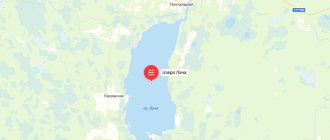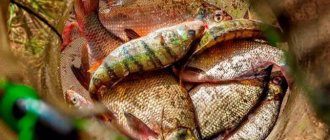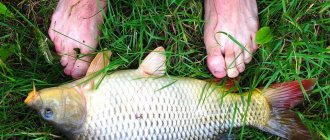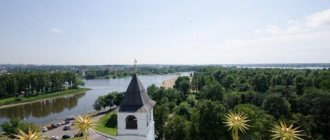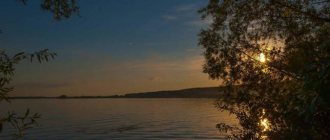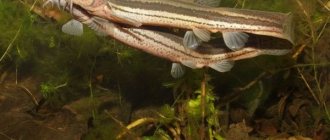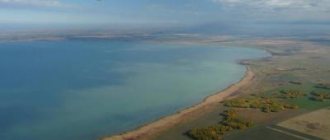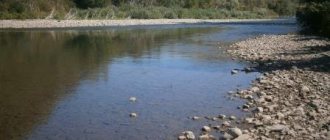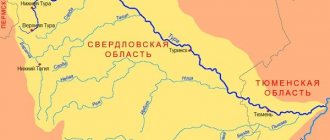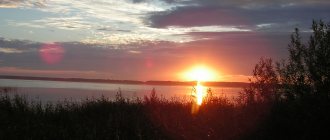Lake Bolshoy Kisegach, located in the Chebarkul region, is considered the most popular and visited among the reservoirs of the same name in the Chelyabinsk region. It is located 5 km from the regional center and 80 km west of Chelyabinsk. Since 1969, the lake has been included in the list of natural hydrogeological monuments. The picturesque Ilmensky Nature Reserve, founded almost 100 years ago, is closely adjacent to its western shore. From the north and northeast, access to the reservoir is limited by high cliffs. Recreation areas are concentrated on the southern coast, partly in the southeast.
View of Bolshoi Kisegach, © lex67 25
The best places in the Chelyabinsk region where you can fish
Lake Sugoyak
What kind of fish is found: chebak, perch, crucian carp, medium-sized pike, ruffe, bream, carp, pike perch, whitefish and ripus.
A large lake in the Krasnoarmeysky district of the Chelyabinsk region. It is surrounded from different sides by many settlements and tourist centers. However, such crowds did not make it less popular among fishermen. On weekends, along the coast you can see cars with license plates from neighboring regions. To enter, use the left side of the reservoir - it is freer from private lands.
People pass on legends about large crucian carp that were found here during the Soviet years. Then the lake was specially stocked with fish. But now they are not doing this. Nevertheless, there is enough catch for everyone. Everyone has a chance to catch their golden carp. Especially in the dark.
Please note that in the Chelyabinsk region another lake with the same name is available for fishing - Sugoyak-2. There is no such dense private development there. It is smaller in size, but is also popular among fishermen.
Lake Uvildy
What kind of fish is found: perch, tench, pike, crucian carp, roach, dace, bream, rarely whitefish.
The lake is a legend, the pride of the Chelyabinsk region. Officially located in the register of natural monuments. Its area exceeds the size of the southern European state of San Marino. Why legend? Firstly, this is an ancient body of water, which, according to scientists, arose millions of years ago. Secondly, even in the hottest summer the water remains scalding cold. Nearby there are radon springs, the water of which is used for therapeutic baths in local sanatoriums.
Due to the size of the reservoir, even spearfishing is practiced on the lake. There are also crayfish here. Fishing from the shore is free, but for underwater or from boats you need to buy a ticket. This can be done at one of the local bases. From November 1 to December 10, fishing is prohibited.
Lake Big Kisegach
What kind of fish are found: tench, crucian carp, pike, perch, chebak, ruffe, smelt, whitefish.
Bolshoi Kisegach is located in the Chebarkul region. The lake closes the top three largest lakes in the region and has the status of a natural monument. The water here is clear to the very bottom - 10 meters. Although there are also deep areas where the bottom reaches more than 30 meters.
On the territory of the lake there are several islands that were once mountain peaks. In winter, fishermen come here for smelt. Fishing in the summer is also possible and necessary. Experienced fishermen manage to catch whitefish. From November 1 to December 10, there is a fishing ban.
A kilometer from Big Kisegach is its “younger brother” - Small Kisegach. It is also worth going there for fishing.
Lake Treustan
What kind of fish are found: perch, crucian carp, carp, pike perch, chebak, ripus.
You can fish here both from the shore and by boat. Photo: pexels.com
The lake is located on the border with the Kurgan region. Please note that the road leading to the pond is poor. It is better not to drive a weak car in bad weather.
Treustan is divided into two parts, connected by an isthmus. You can fish everywhere. Part of the reservoir is occupied by a flooded forest. This imposes its own characteristics: the bottom has snags in which carp likes to hide. The main thing is not to damage the gear.
You can fish both from the shore and from a boat. But you need to buy a ticket on the west coast. Fishing is prohibited from May to mid-June.
This is interesting: Big Kialim: fishing and what kind of fish is found
Lake Bolshoi Kisegach in Chebarkul district
Lake Bolshoy Kisegach, located in the Chebarkul region, is considered the most popular and visited among the reservoirs of the same name in the Chelyabinsk region. It is located 5 km from the regional center and 80 km west of Chelyabinsk.
Since 1969, the lake has been included in the list of natural hydrogeological monuments. The picturesque Ilmensky Nature Reserve, founded almost 100 years ago, is closely adjacent to its western shore. From the north and northeast, access to the reservoir is limited by high cliffs.
Recreation areas are concentrated on the southern coast, partly in the southeast.
View of Bolshoi Kisegach, © lex67 25
Recreation centers on Bolshoi Kisegach
Near the reservoir, surrounded by a pine forest, there are several objects with budget summer houses and comfortable buildings.
One of the very first sanatoriums for Soviet citizens, “Kisegach,” was built on the southern bank of Bolshoy Kisegach in 1926.
Despite its venerable age, the health resort still continues to receive vacationers and provide therapeutic and preventive procedures at the highest level. Nowadays, the Kisegach sanatorium is considered one of the best institutions in its industry, based in the Southern Urals.
Here they treat the circulatory and nervous systems, respiratory organs and diseases of the musculoskeletal system. Therapeutic mud is delivered to the health resort from Bolshoi Volash.
Picturesque views of the surrounding nature and the healing aromas of coniferous forests contribute to recovery and a pleasant holiday at the reservoir.
Water activities, © Aksenov Andrey
In addition to the Kasegach sanatorium, on the southern shore of the lake there are recreation centers, boarding houses and campsites. The most popular are:
- "Birch";
- "Squirrel";
- "Smile";
- "Cliff";
- "Herringbone."
On the territory there are equipped beaches, barbecue areas, rental points for water equipment, children's and sports grounds, and parking spaces. Three meals a day are provided upon request, and entertainment is provided in the evenings.
Sunset over the lake, © Alexander Tsykunkov
Fishing on Bolshoi Kisegach
The lake is home to more than a dozen species of fish, including tench, pike, whitefish, chebak and even smelt. Fishing rods are cast from banks, pontoon bridges and boats. Winter fishing is especially popular among amateurs. On weekends, entire tent cities appear on the ice. High water transparency allows for spearfishing.
Experienced fishermen assure that Bolshoy Kisegach is capricious, so it rewards only those who know and love the body of water with good catches.
Beach holiday, © Aksenov Andrey
It’s not difficult to find a place for wild recreation on the shore of the reservoir. It is pointless to look for a parking lot on the western side, since access to the Ilmensky Nature Reserve is limited, and from the north access to the lake is difficult due to steep rocks. Tents are placed in the south and southeast of the reservoir. Visitors sunbathe, swim, fish and cook over fires.
Before you go on vacation, you should look at weather forecasts for 10 days.
Camping with tents, © Son Aether
Features of the lake
It is assumed that the Greater Kisegach basin was formed 13 thousand years ago as a result of tectonic processes. Subsequently, it changed its shape and size more than once, filled with water and became overgrown with dense forests, which replaced the vegetation characteristic of the tundra.
Lake Bolshoy Kisegach is located in the foothills of the Ilmen Mountains, which are a natural barrier to the western and northwestern winds.
The coastline, indented by numerous bays, is made of rock. The extremely uneven bottom has sharp changes, and therefore in the water column there is a significant temperature difference in adjacent water layers. The difference between the surface and bottom zones can be about 10–15 degrees.
Seasonal streams that dry up in the summer, as well as channels and more or less permanent rivulets flowing into the Big Kisegach. The flow from the reservoir occurs into Maly Kisegach. In the surrounding area there are natural springs gushing out of the ground.
Rocky shore, © Andrey Medvedev
The lake stretches at almost 230 meters above sea level. Its dimensions are:
- area - more than 14 sq. km;
- depth - 32–33 m (max.) and 12–14 m (average);
- The length of the coastline is 26 km.
In terms of depth, Bolshoi Kisegach ranks third in the Chelyabinsk region - after lakes Uvildy and Turgoyak. The volume of water in the lake varies depending on the amount of precipitation. In dry years, when the level of the water surface noticeably decreases, 5 more chars, representing rocky peaks, are added to the 11 islands that are constantly visible in the water area.
The transparency of the lake water reaches 10 meters.
One of the features of Big Kisegach is its untouched nature by civilization. No ancient sites have been found here, and there are no villages on the shore (only a small holiday village). During the time of widespread construction of Demidov factories, the territory was classified as difficult to develop, and therefore economically inexpedient. It is possible that this fact helped the reservoir avoid large-scale pollution.
One of the islands, © Aksenov Andrey
However, for a short period, a clay quarry was developed near Bolshoi Kisegach. The mined rock was washed with lake water and sent as raw material to factories for the production of porcelain products. The enterprise was allegedly destroyed by the Pugachevites. The owners decided not to waste time and money on restoration work.
Many are sure that Old Believers once hid in the wilderness near the reservoir, fleeing persecution. In the 19th century, the shores of Bolshoy Kisegach were built up with the dachas of local rich people, and a road was even marked on the maps of those years.
Several lakes of tectonic origin are grouped around the reservoir:
- Terenkul;
- Maly Kisegach;
- Spruce;
- Big Sunkul;
- Chebarkul;
- Big Wolyash.
Bolshoi Kisegach, © lex67 25
Name of the reservoir
The toponym Kisegach refers to a whole group of objects located in the Chelyabinsk region. This:
- Bolshoi Kisegach - two lakes in Kasli and Chebarkul regions;
- Maly Kisegach - four lakes in Chebarkul, Kasli, Sosnovsky and Argayash regions;
- two villages - on the shore of the Kasli Lake Bolshoi Kisegach and 4 km from the Chebarkul Bolshoi Kisegach;
- railway station - on the South Ural Railway between Chebarkul and Miass.
The name “Kisegach” implies a combination of two Tatar words and when translated into Russian it sounds like cutting down (or cutting) trees (or forest). In other words, this is a lake where trees can be cut down.
An alternative opinion is that the first part of the toponym can be translated as “steepness,” which is associated with the steep banks of a reservoir. However, other objects, in particular Sosnovskoye Lake, have neither steepness nor dense forest vegetation in the area.
Therefore, local historians are still trying to find common features between reservoirs in order to more thoroughly understand the true meaning of the toponym.
In some sources you can find interpretations of the name of Chebarkul Lake. The most common are Kisega (map of 1742), Kis-Agach, Kisetagash, Kisigach, Kosegach and even Kisulgaz.
Mountains on the horizon, © lex67 25
You can get to the reservoir by public transport or private car.
By bus and electric train
Every day, bus routes No. 510, 511 and 551 depart from the Central Bus Station of Chelyabinsk towards Miass. You need to get off the transport at the “Elovoe Sanatorium” stop. Next - 1.5 km on foot.
On flights No. 513 and 532 from the bus station and electric trains from the Chelyabinsk railway station you can get to Chebarkul, after which you can transfer to local minibuses going to Lake Bolshoi Kisegach.
Timetables:
By car
From Chelyabinsk you should go west along the Ural highway (M-5). Behind the village of Timiryazevsky there will be a right turn towards Chebarkul. After the railway crossing, Lake Misyash will appear, and literally a kilometer later there will be a road sign.
If you turn right towards the Beryozka base, the path will lead to the eastern bank of Bolshoy Kisegach. When driving straight along Shosseynaya Street towards the Miass Highway, you will need to follow the sign for Kisegach and turn right.
This road will lead to the southern shore of the lake.
Lake Big Kisegach: video
Source: https://www.tourister.ru/world/europe/russia/city/chebarkul/lakes/30306
What kind of fish can you catch in the Chelyabinsk region
Perch
Permitted tackle: summer and winter fishing rods, donks, spinning rods, wire rods, mugs, girders, fly fishing, vertical lures with a single hook, as well as a “rocker” type lure with a hook no larger than number seven
Bait: worm, bloodworm, roach, gudgeon, leech, crustacean molluscs
Permissible weight of the catch: with hook gear - no more than 5 kg per day on public water bodies, on the rest it is established by the tenant of the reservoir
Perch bites well in December. Photo: Sergey KUROCHKIN
Perch competes for the title of the main predator of the Ural reservoirs with pike. The best time to go there is from March to September. He also walks on the first ice, that is, around December. Doesn't bite in the heat. According to the observations of fishermen, it is better to catch at dusk and approximately from 9:00 to 15:00.
crucian carp
Permitted gear: summer, bottom, winter fishing rods, spinning rods, wire rods, live bait and fly fishing rods, sheer lures with a single hook, lure “rocker” (hook no more than No. 7)
Bait: maggot and bloodworm, you can combine them. Other small insects will do. The simplest thing is to roll up a ball of bread. You can mix it with honey gingerbread
Allowable catch weight: no more than 5 kg per day, although rented reservoirs may have their own conditions
Crucian carp is caught at night or early in the morning. Photo: globallookpress.com
Some consider crucian carp one of the most capricious and weather-dependent fish. Others are the most undemanding. They catch crucian carp in late spring, all summer and in September, best at night and early in the morning.
Pike
Allowed gear: summer, bottom, winter fishing rods, spinning rods, wire rods, live bait and fly fishing rods, vertical lures with a single hook, lure “rocker” (hook no more than No. 7). The total number of hooks per fisherman or boat, no matter how many people sit in it, should not exceed five.
Bait: Artificial baits such as spinners and wobblers. Large fish are caught using natural bait - frogs, shrimp, crayfish meat
Allowable catch weight: up to 5 kg per day, if there are no other limits on the reservoir served by private owners. Pike under 30 cm must be released by law
Pike smaller than 30 cm will have to be released. Photo: globallookpress.com
The large predator lives in many reservoirs of the Chelyabinsk region. The ideal time for fishing is from April to October. Although in the summer months the fish can show character: it already has enough food. It's best to fish early in the morning or as dusk approaches.
Chebak
Permitted tackle: spinning rod, donka, wire rod, live bait, summer and winter fishing rods, ships, mugs, girders, spoons with a single hook and a “rocker”, but with hooks no larger than number seven
Bait: worms and insects - bark beetles, maggots, bloodworms, lamprey larvae. Barley, bread or raw dough will do.
Allowable catch weight: up to 10 kg
A species of roach that lives in large numbers in the reservoirs of the Chelyabinsk region. The fish is omnivorous. It moves in schools, so if you hook one chebak, feel free to cast the tackle again, and very soon you will catch more fish. It does well in early spring before spawning and in mid-autumn. In summer, activity decreases slightly. It bites all day and night. However, small fish choose daytime, while fatty individuals are active in the evening.
Carp
Acceptable gear: mugs, girders, spinning rods, bottom, live bait, winter fishing rods, summer, wire, fly fishing rods
Bait: worm, maggot, caddis larvae. If the fish is hungry, especially in late autumn, then the meat of other fish, shrimp, and mussels will do. Carp does not disdain vegetable bait and dough
Allowable catch weight: 10 kg. But to catch so many of these fish, you need a lot of luck. Reservoirs with artificial stocking may have their own limits.
Carp bite from May to October. Photo: globallookpress.com
This fish is distinguished by its omnivorous nature. Fishermen like to compare it with domestic pigs: they say it eats everything, gets fat, and then goes to feed. Carp bite from May to October. During the cold months the fish are inactive. It is best to fish at dusk and at first dawn.
Red Book species
Sterlet
Valuable fish, which is rare, but found in the Chelyabinsk region. Listed in the Red Book. Regional fishing regulations prohibit hunting it. The fish is medium-sized and belongs to the sturgeon family. It lives a long time - up to 30 years, but begins to spawn quite late. Males mature at four years of age, and females at seven. Meat is considered a great delicacy, so sterlet is bred in fish farms.
Fishing fine: RUB 4,572. regardless of size.
Taimen
Taimen can reach enormous sizes. Once caught, this fish must be released. Photo: Igor OLKHOVSKY
A very large fish from the salmon family. It can reach a length of two meters and a colossal size of 80 kg. Rare, but found in reservoirs of the Southern Urals. If you catch taimen, you must release it.
Fishing fine: RUB 10,635. for each individual.
Common sculpin
An unusual fish that swims very poorly. Its movement resembles sliding along the bottom. Lives in mountain reservoirs with clean and cold water. For camouflage it has a sandy color. It lives in the west of the Chelyabinsk region, closer to the border with Bashkortastan.
Fine for catching: up to 5,000 rubles.
Brook trout (trout)
It is a valuable commercial species. Fishing in the Chelyabinsk region is prohibited, although artificial breeding is possible. It is interesting because depending on its habitat, the fish have different colors. Of course, it doesn’t adapt to its environment like a chameleon. It’s just that the same trout in different reservoirs has a different “design” of scales.
Fishing fine: RUB 5,128. for each trout caught.
Kisegach (lake). Recreation centers on Lake Kisegach
In the Urals, in the Chelyabinsk region, there is a system of lakes of remarkable beauty, the name of which contains the word Kisegach. They are found where lowland meets mountainous terrain. Due to tectonic activity, cracks, faults, and folds first appeared in the earth's crust, and then they were filled with water. This is how lakes were formed.
Where the forest is cut down
They say that the name of the lakes was invented by local Bashkirs. The word "kisegach" means a place, in this case a lake, where wood is cut down. There really are a lot of forests on the shores of the lakes. However, they came to this name not very long ago.
In ancient times, in various sources it was written differently (Kisigach, Kis-Agach, Kisegatash and the like). This name has also been translated in different ways. For example, there was also such a meaning as “lake with steep banks.”
There are five lakes with a similar name in the Chelyabinsk region. In the Chebarkulsky district there are Big and Small Kisegach, in the Sosnovsky district there is simply Kisegach, in Kaslinsky there are two more lakes with the same name.
The largest and most beautiful of them is Bolshoi Kisegach. The lake is located in the Chebarkul region, a resort region of the Southern Urals, and is popular among those who like to relax in nature.
Lake Bolshoi Kisegach is of ancient origin. Its age, according to scientists, may be about 13 thousand years.
Of course, over such a long period the lake not only changed its shape, but also became warmer and colder depending on the climate.
Once upon a time, tundra ran along its banks. Deciduous forests rustled here about nine thousand years ago. And now in these places you can find birch, pine, oak, linden, elm and other deciduous trees.
The pristine nature of these places has been preserved, probably because they were not inhabited for a long time.
At least archaeologists have not yet found evidence of sites near the Big Kisegach of primitive people. No traces of habitation from a later period were found.
Only there are burials of ancient skit origin. Scientists suggest that it was the Old Believers who were hiding here from persecution by the authorities.
Deep and transparent
The area of the lake is about 15 square kilometers. Kisegach is a lake that stretches more than six kilometers in length and four in width.
In the Chelyabinsk region, Bolshoi Kisegach is one of the three deepest lakes.
Its maximum depth is 33 meters. Only lakes Turgoyak and Uvildov are considered deeper than it. The depth of the latter reaches 38 meters. The average depth of Lake Kisegach along its entire length is 10 meters.
The water on this forest lake is very clean, almost transparent. The bottom is visible at a depth of up to 10 meters. That’s why holidays on Lake Kisegach are so valued.
In addition, this is a lake with running water. Six small rivers flow into it, which mainly originate in the Ilmen Mountains. Some of them connect Kisegach Lake with other bodies of water in the Ural region, thereby facilitating travel to these places by boats and catamarans.
Picturesque shores
The coastline of this Ural lake stretches for 26 kilometers. And there is hardly a corner on it that would not attract with its unique beauty.
Slender pine and birch trees rise on the rocky slopes of the banks, as well as many other trees and shrubs. At the same time, here and there along the entire coast there are cozy bays, chicken bays and sandy beaches.
It is not surprising that recreation centers on Lake Kisegach are popular.
In 1969, the surroundings of Bolshoi Kisegach and the lake itself received the status of a natural monument and protected area. In addition, the western shore of the lake comes close to the Ilmensky State Nature Reserve.
Numerous islands
Twelve islands are located among the water surface of Lake Bolshoi Kisegach. They are different in size and their picturesqueness. Sedlovaty, Vysokiy, Lipovy, Donskoy, Kopeshka... Some names speak for themselves, some are based on local legends and customs. There are also islands on the lake without names.
At a time when the water level in the lake decreases (either due to the heat, or for other reasons), stone ridges called chars protrude from under the water. Birds love to rest on them.
By the way, there are a lot of birds on the Kisegacha Islands. They nest there and stop to rest during long flights.
After all, Big Kisegach is a lake rich in fish, and it is also well protected from the winds, since it is surrounded by hills on almost all sides.
Fishing Island
Not only the wonderful nature attracts vacationers to Kisegach, but also great fishing opportunities. There are a lot of different fish here: pike, perch, crucian carp, chebak, ruff, tench, ide. And even smelt and whitefish, rare for these places, are found. The latter can be very large.
Fishing enthusiasts not only occupy the shores of the lake, but also explore the islands. And in winter they fish directly from the ice, setting up entire tent settlements on it. What attracts them most at this time of year is smelt.
There may be an opportunity to hunt on Lake Kisegach, but for this you need to obtain permission from the local forestry departments. But on the territory of the Ilmensky Nature Reserve, which borders the lake in the west, both hunting and fishing are prohibited.
Recreation centers on Lake Kisegach
Of course, you can relax on the lake on your own, as a tourist, with a backpack and a tent. However, not everyone likes this type of holiday. There is an alternative: sanatoriums and recreation centers.
Already in Soviet times, Kisegach was a famous balneological resort in the Southern Urals. The first holiday home was opened in 1926. During the war there was a hospital there, and in the post-war period the Kisegach sanatorium opened.
It is still considered one of the best health resorts in the Urals.
In addition to coniferous forests and clean air, the sanatorium offers mineral baths, procedures with sapropel mud, hydromassage, magnetic therapy and other various treatments.
If you do not prioritize treatment, then boarding houses and bases on Lake Kisegach are suitable for a good rest. For example, you can stay at the Utes boarding house or at the Ural Dawns recreation center.
This list can be continued: “Ogonyok”, “Metallurg”, “Kisegach” - these are all recreation centers. Guests are welcome both at the Solnechnaya Dolina ski complex and at the Utesoff hotel complex. And in the dacha village of Kolokolenki you can rent a house.
So the choice is quite large, the main thing is the desire to go to these wonderful places.
Free fishing
3
Fishing in the Chelyabinsk region in 2021 and 2022 is free in many places. Local residents fish right within the city on the Shershnevskoye Reservoir, the Miass River, the First and Second Lakes, and Smolino.
You can go fishing for free on many lakes and rivers in the Chelyabinsk region. Photo: pexels.com
Fans of beautiful views choose mountain rivers for fishing - Ay, Yuryuzan, Sim. You can go to Zyuratkul - a lake in the middle of a national park, surrounded on all sides by mountains. Or go fishing on the largest lake, which is called the “Ural Sea” - Turgoyak.
The following lakes are also popular among fishermen: Kaldy, Uelgi, Sungul, Urefty, Akakul, Argazin Reservoir, Kirety, Kumkul, Kasargi.
Paid fishing
| Place name | Price |
| "Fisherman's Outpost" (PKiO Gagarin) | 500 rub. |
| Alabuga | 300 rub. |
| Baynaush | 100-350 rub. |
| Berezovsky | 100 rub. + 90 rub. for each carp |
| Big Kuyash | 100 rub. |
| Butash | 100 rub. |
| Kataevsky quarry | 200 rub. |
| Kichkibis | 200 rub. |
| Krasnokamensky Pond | 100-200 rub. |
| Kukan | 150 rub. |
| Tarhun quarry | 100-300 rub. |
| Tatysh | 300 rub. + 100 rub. for every kilogram over 5 kg |
| Teren-Kul | 200-300 rub. |
| Terenkul | 100-200 rub. |
| Ulagach | 100-200 rub. |
Prices are for 2021.
This is interesting: Big Kremenkul Lake: fishing and what kind of fish is found
Fishing rules in the Chelyabinsk region
Fishing in the Chelyabinsk region in 2021 takes place taking into account the rules in force for the West Siberian fishery basin. The main provisions were commented on by the President of the Chelyabinsk Region Fishing Federation Nikolai Federyagin .
- Remember that in the Chelyabinsk region industrial fishing and fishing from a boat is prohibited in all reservoirs from May 5 to June 15 . In the Troitsky and South Ural reservoirs, as well as Lake Ulagach - from April 25 to June 5. From November 1 to December 10, it is prohibited to catch all whitefish on lakes Uvildy, Turgoyak and Bolshoi Kisegach. On these dates, fishing from the shore is allowed with one hook and one rod per angler.
- What gear and fishing methods are possible. Fishing rods - donks, summer, winter, wire, fly fishing, live bait, spinning. Rowing boats are allowed (except during the spawning period), gear includes a boat, mugs and up to five girders. You can buy a sheer spoon with a single hook. The total number of hooks per fisherman should not be more than five.
When going fishing, familiarize yourself with the regulations in force in that region. Photo: Vladimir VELENGURIN
- Fans of underwater hunting can use a harpoon or a gun loaded with it. An important condition - no scuba gear or other breathing devices. You cannot dive with a harpoon where there are large numbers of people relaxing.
- The use of explosives, electricity and poison is prohibited . You cannot use nets, trawls, traps and other handicrafts.
- Outside the spawning season, watercraft . The number must be clearly legible on the case. This does not apply to boats with a carrying capacity of up to 100 kg, kayaks - up to 150 kg and inflatable boats - up to 25 kg.
- You are allowed to catch no more than 10 kg of fish per day . However, some species have their own rules. For example, for grayling - 3 kg (or 15 specimens); for asp, pike perch, pike, catfish, bream, burbot, ide - no more than 5 kg. The limit of crayfish is 30 individuals.
- For bait, you cannot take fry of pike, asp, pike perch, grayling bream and other fish from the Red Book.
- In the Techa River, as well as its tributaries and floodplains , due to the radiation accident that occurred in the 20th century and repeated waste discharges, any fishing is prohibited.
Fishing on Lake Bolshoi Kisegach
The nature of the Chelyabinsk region is harsh in the Ural style, but surprisingly beautiful. Virgin forests and ancient mountains, blue lakes and fast rivers, an abundance of forest animals and river and lake fish. One of the most famous natural attractions of the Chelyabinsk region is Lake Bolshoi Kisegach.
Recreation and
fishing on Lake Bolshoi Kisegach
attract both residents of this region and numerous guests. Lake Kisegach is located in the Chebarkul resort area. The length of this lake is 6140 meters and the width is 4070 meters. Lake Big Kisegach is connected to Lake Small Kisegach through the Chartonyshka River. The greatest depth in the lake reaches 35 meters. 6 rivers flow into the lake. On the western shore of the lake there are specially protected areas that are part of the Ilmensky Nature Reserve.
The nearest town of Chebarkul is located 5 kilometers from the lake. There are 20 islands on the lake; this is where the most catchy fishing spots on this body of water are located. Most of these islands are in the northern part of the lake. The largest of the islands, known as “Big”, is about 500 meters long and 260 meters wide.
Fishing on Lake Bolshoi Kisegach
carried out on an area of 1420 hectares. And the total length of the lake coast is 26 kilometers. The depths of this lake are very different in the south and in the west of Bolshoi Kisegach there is a sharp difference in depth. For example, at a distance of 130-150 meters from the shore, the bottom can sharply go into a depth of 20 meters or more. And the deepest place is located between the islands in the center of the reservoir and is fixed at around 35.3 meters.
In the lake there is also a fairly large temperature difference between the surface layer of water and the bottom layer, and in some places it can reach 130C. The water here has good transparency from 10 to 12 meters, in some places even 15 meters. Therefore, the lake is well suited for spearfishing. Big Kisegach is distinguished by good flow because 6 rivers flow into this lake. In addition, this reservoir is fed by groundwater and melt water.
As already described above, there are two dozen islands on the lake, 6 of them are large islands consisting of rock formations. These are former mountain peaks that were under water when this lake was formed after a tectonic fault. Many islands have steep coastlines consisting of granite and basalt slabs. The tall island is considered the most beautiful because of its bizarre stone piles. On another island called Lipovy, under the influence of wind and heavy rains, a kind of stone canopy was formed in the rocks. When there are dry years, the tops of other ancient rocks resting on the bottom of the cliffs may emerge from the water. There are many gulls on the islands, which mainly live on their southern shores.
Fishing and fish
Fishing trophies caught in the waters of Lake Big Kisegach are conventionally divided into native fish species that have lived in the waters of this lake from time immemorial and those that were artificially stocked here.
The original fish species in this reservoir include chebak, crucian carp, perch and pike. Fish introduced into the lake and not previously inhabited it include smelt, rudd, bream, burbot, and whitefish. The latter species, Siberian whitefish, is of particular interest to fishermen. And it is no coincidence, because this fish has very tasty and healthy meat. This fish has taken root here very well and in modern times the weight of this whitefish can often reach 3 kilograms.
To catch whitefish, experienced fishermen use unusual gear in these places. Whitefish fishing in Lake Bolshoi Kisegach
occurs on a tackle resembling a garland, equipped with 12 hooks and fishing line with a diameter of 0.15-0.17 mm. At the end of such tackle there is a large jig weighing 4 grams.
You can get to Lake Kisegach from the city of Chebarkul by traveling a little over 5 kilometers by bus from the Chebarkul bus station. To get to Lake Bolshoi Kisegach from Chelyabinsk, you need to leave from the South Station and drive 90 km to the lake. This is perhaps the best option, not counting personal transport.
Other lakes of the Chelyabinsk region
Of course, in addition to Lake Bolshoi Kisegach, there are many other beautiful and fish lakes in the Chelyabinsk region where you can have good fishing and just relax.
Lake Kum-Kul
This sandy lake is located 50 kilometers from Chelyabinsk, an excellent place for a beach holiday and successful fishing. However, due to private developments, it has become inaccessible for free recreation.
Lake Kum-Kul itself and its picturesque surroundings are a magnificent place where you can relax calmly from the bustle of the city. The reservoir is very clean, the water has high transparency. On its coast there are beautiful sandy beaches, and around there are delightful birch groves. The lake is also famous for its abundance of fish. Typically, fish species caught here include peled, perch, pike and crucian carp. Around the reservoir there are a large number of fishing and tourist centers that provide vacationers and fishermen with various services.
Also, for recreational purposes, you can visit the lake for independent recreation, pitch a tent on the shore and enjoy the wonderful nature of these places.
Spruce Lake
The lake is located in the Chebarkul region. This reservoir is protected by law and is a natural monument. The lake is located 1.5 kilometers from the city of Chebarkul and 90 kilometers from the city of Chelyabinsk.
The lake is 2200 meters long and 1900 meters wide. The water surface of Lake Elovoe has an area of 3120 m2. And the length of the coastline is 9.8 kilometers. The reservoir has a round shape, and its bottom is replete with varied topography. Which is a good indicator for fishing. The waters of the lake are home to many different fish, but the main fish caught here are perch, pike, crucian carp and chebak.
The lake has steep shores, the Elovka River flows into the southern part of the lake, and the small Gudkovka River flows into its western part. This lake, due to its small size and good shelter from the winds, warms up well.
You can also have a great time relaxing and fishing on lakes Chebarkul and Itkul
,
Maly Kisegach
, and many others, which are abundant in this region.
Have a nice holiday and fishing!
Morphometry
- Catchment area: 114 km².
- Length: 6.3 km.
- Width: 4.5 km.
- Mirror area: 15.4 km².
- Volume: 268,200,000 m³.
- Average depth: 12 m.
- Maximum depth: 34 m.
Relaxing on the lake with a tent=»off»>
It’s not difficult to find a place for wild recreation on the shore of the reservoir. It is pointless to look for a parking lot on the western side, since access to the Ilmensky Nature Reserve is limited, and from the north access to the lake is difficult due to steep rocks. Tents are placed in the south and southeast of the reservoir. Visitors sunbathe, swim, fish and cook over fires.
Before you go on vacation, you should look at weather forecasts for 10 days.
Weather in Chebarkul (5 km from Bolshoy Kisegach)
Camping with tents, © Son Aether
Features of the lake="off">
It is assumed that the Greater Kisegach basin was formed 13 thousand years ago as a result of tectonic processes. Subsequently, it changed its shape and size more than once, filled with water and became overgrown with dense forests, which replaced the vegetation characteristic of the tundra.
Lake Bolshoy Kisegach is located in the foothills of the Ilmen Mountains, which are a natural barrier to the western and northwestern winds.
The coastline, indented by numerous bays, is made of rock. The extremely uneven bottom has sharp changes, and therefore in the water column there is a significant temperature difference in adjacent water layers. The difference between the surface and bottom zones can be about 10–15 degrees.
Seasonal streams that dry up in the summer, as well as channels and more or less permanent rivulets flowing into the Big Kisegach. The flow from the reservoir occurs into Maly Kisegach. In the surrounding area there are natural springs gushing out of the ground.
Rocky shore, © Andrey Medvedev
The lake stretches at almost 230 meters above sea level. Its dimensions are:
- area - more than 14 sq. km;
- depth - 32–33 m (max.) and 12–14 m (average);
- The length of the coastline is 26 km.
In terms of depth, Bolshoi Kisegach ranks third in the Chelyabinsk region - after lakes Uvildy and Turgoyak. The volume of water in the lake varies depending on the amount of precipitation. In dry years, when the level of the water surface noticeably decreases, 5 more chars, representing rocky peaks, are added to the 11 islands that are constantly visible in the water area.
The transparency of the lake water reaches 10 meters.
One of the features of Big Kisegach is its untouched nature by civilization. No ancient sites have been found here, and there are no villages on the shore (only a small holiday village). During the time of widespread construction of Demidov factories, the territory was classified as difficult to develop, and therefore economically inexpedient. It is possible that this fact helped the reservoir avoid large-scale pollution.
One of the islands, © Aksenov Andrey
However, for a short period, a clay quarry was developed near Bolshoi Kisegach. The mined rock was washed with lake water and sent as raw material to factories for the production of porcelain products. The enterprise was allegedly destroyed by the Pugachevites. The owners decided not to waste time and money on restoration work.
Many are sure that Old Believers once hid in the wilderness near the reservoir, fleeing persecution. In the 19th century, the shores of Bolshoy Kisegach were built up with the dachas of local rich people, and a road was even marked on the maps of those years.
Several lakes of tectonic origin are grouped around the reservoir:
- Terenkul;
- Maly Kisegach;
- Spruce;
- Big Sunkul;
- Chebarkul;
- Big Wolyash.
Bolshoi Kisegach, © lex67 25
Reservoir name="off">
The toponym Kisegach refers to a whole group of objects located in the Chelyabinsk region. This:
- Bolshoi Kisegach - two lakes in Kasli and Chebarkul regions;
- Maly Kisegach - four lakes in Chebarkul, Kasli, Sosnovsky and Argayash regions;
- two villages - on the shore of the Kasli Lake Bolshoi Kisegach and 4 km from the Chebarkul Bolshoi Kisegach;
- railway station - on the South Ural Railway between Chebarkul and Miass.
The name “Kisegach” implies a combination of two Tatar words and when translated into Russian it sounds like cutting down (or cutting) trees (or forest). In other words, this is a lake where trees can be cut down. An alternative opinion is that the first part of the toponym can be translated as “steepness,” which is associated with the steep banks of a reservoir. However, other objects, in particular Sosnovskoye Lake, have neither steepness nor dense forest vegetation in the area. Therefore, local historians are still trying to find common features between reservoirs in order to more thoroughly understand the true meaning of the toponym.
In some sources you can find interpretations of the name of Chebarkul Lake. The most common are Kisega (map of 1742), Kis-Agach, Kisetagash, Kisigach, Kosegach and even Kisulgaz.
Mountains on the horizon, © lex67 25
Features of the lake
It is assumed that the Greater Kisegach basin was formed 13 thousand years ago as a result of tectonic processes. Subsequently, it changed its shape and size more than once, filled with water and became overgrown with dense forests, which replaced the vegetation characteristic of the tundra.
Lake Bolshoy Kisegach is located in the foothills of the Ilmen Mountains, which are a natural barrier to the western and northwestern winds.
The coastline, indented by numerous bays, is made of rock. The extremely uneven bottom has sharp changes, and therefore in the water column there is a significant temperature difference in adjacent water layers. The difference between the surface and bottom zones can be about 10–15 degrees.
Seasonal streams that dry up in the summer, as well as channels and more or less permanent rivulets flowing into the Big Kisegach. The flow from the reservoir occurs into Maly Kisegach. In the surrounding area there are natural springs gushing out of the ground.
Rocky shore, © Andrey Medvedev
The lake stretches at almost 230 meters above sea level. Its dimensions are:
- area - more than 14 sq. km;
- depth - 32–33 m (max.) and 12–14 m (average);
- The length of the coastline is 26 km.
In terms of depth, Bolshoi Kisegach ranks third in the Chelyabinsk region - after lakes Uvildy and Turgoyak. The volume of water in the lake varies depending on the amount of precipitation. In dry years, when the level of the water surface noticeably decreases, 5 more chars, representing rocky peaks, are added to the 11 islands that are constantly visible in the water area.
The transparency of the lake water reaches 10 meters.
One of the features of Big Kisegach is its untouched nature by civilization. No ancient sites have been found here, and there are no villages on the shore (only a small holiday village). During the time of widespread construction of Demidov factories, the territory was classified as difficult to develop, and therefore economically inexpedient. It is possible that this fact helped the reservoir avoid large-scale pollution.
One of the islands, © Aksenov Andrey
However, for a short period, a clay quarry was developed near Bolshoi Kisegach. The mined rock was washed with lake water and sent as raw material to factories for the production of porcelain products. The enterprise was allegedly destroyed by the Pugachevites. The owners decided not to waste time and money on restoration work.
Many are sure that Old Believers once hid in the wilderness near the reservoir, fleeing persecution. In the 19th century, the shores of Bolshoy Kisegach were built up with the dachas of local rich people, and a road was even marked on the maps of those years.
Several lakes of tectonic origin are grouped around the reservoir:
- Terenkul;
- Maly Kisegach;
- Spruce;
- Big Sunkul;
- Chebarkul;
- Big Wolyash.
Bolshoi Kisegach, © lex67 25
Hydrology
- Availability of permanent drainage: yes, wastewater.
- Tributaries: Lake Terenkul, Lake Big Sunukul, several nameless streams.
- Swimming pool: Karassi River.
- Bottom: rocky and pebbly, muddy in places.
Chemical composition
- Water: fresh.
- Salinity: 0,25
G/l.
- Water class according to salt composition: hydrocarbonate-sulfate-sodium-calcium.
- Transparency: 10 m.
Geography
- Coordinates: 55°02′33″ N. latitude, 60°18′45″ e. d.
- Altitude above sea level: 317 m.
- Coastal landscape: the reservoir is located among small hills overgrown with mixed forest. Along the highly developed coastline there are periodically small swamps. There are several recreation centers on the southern shore, and Lake Terenkul is actually adjacent to the reservoir. The West Bank has the status of a specially protected area.
Territorial location
- COUNTRY: RF . Region: Chelyabinsk region . Districts: Miass, Chebarkul.
Interactive map
How to get to Lake Bolshoi Kisegach
You can get to the reservoir by public transport or private car.
By bus and electric train
Every day, bus routes No. 510, 511 and 551 depart from the Central Bus Station of Chelyabinsk towards Miass. You need to get off the transport at the “Elovoe Sanatorium” stop. Next - 1.5 km on foot.
On flights No. 513 and 532 from the bus station and electric trains from the Chelyabinsk railway station you can get to Chebarkul, after which you can transfer to local minibuses going to Lake Bolshoi Kisegach.
By car
From Chelyabinsk you should go west along the Ural highway (M-5). Behind the village of Timiryazevsky there will be a right turn towards Chebarkul. After the railway crossing, Lake Misyash will appear, and literally a kilometer later there will be a road sign. If you turn right towards the Beryozka base, the path will lead to the eastern bank of Bolshoy Kisegach. When driving straight along Shosseynaya Street towards the Miass Highway, you will need to follow the sign for Kisegach and turn right. This road will lead to the southern shore of the lake.
Lake Big Kisegach: video
Attractions
Ilmensky Reserve
One of the first Russian nature reserves. It was founded on May 14, 1920 by decree of V.I. Lenin. Currently it occupies an area of 303.8 km², located between the settlements of Miass, Karabash and Chebarkul. Adjacent to the lake on the west side. In fact, it is a research and environmental institute as part of the Ural Branch of the Russian Academy of Sciences. The purpose of the reserve is to preserve the unique natural complex in its original form, conduct geological-mineralogical and ecological-biological research, as well as environmental and natural science education of the population.
How to get there (get there)
The following is a list of entrances (approaches) to the reservoir - 2 options.
South Coast (from Chelyabinsk)
- Coordinates: 55°01′17″ N. latitude, 60°18′44″ e. d.
- Distance from Chelyabinsk: 86 km.
- Delivery option: any car.
- How to get there: from Chelyabinsk you should go towards Ufa and Miass - to the city of Chebarkul, which you need to drive along the street. Energetikov - Station - Shosseynaya. After leaving the city, move straight, without turning anywhere. After Lake Tabankul (will be to the right of the road behind a line of trees), after a while there will be signs to the right - to the recreation centers “Kisegach”, “Ulybka”, “Metallurg” (next to the long oval building), almost immediately after them there will be a fork at which you need to turn right. Next you should drive past the recreation center “Utes” to the sanatorium “Kisegach”. The lake will appear to the right of the road. A little before reaching the sanatorium, there are a couple of exits to the right, along which you can also drive to the shore of the lake (one of the exits leads to the pumping station), but in those places the roads are forest dirt roads and can be difficult to pass in wet weather, although some sources indicate that you can drive along them along the entire eastern coast of the lake.
South Coast (from Yekaterinburg)
- Coordinates: 55°01′17″ N. latitude, 60°18′44″ e. d.
- Distance from Yekaterinburg: 263 km.
- Delivery option: any car.
- How to get there: from Yekaterinburg you need to go in the direction of Chelyabinsk. After the village of Tubuk, turn right to Kasli, then move in the direction of this city. Having passed it, continue driving to Kyshtym, you should also pass it and then move to Kuznetsky, on the outskirts of which turn right - to Uvildy, then left - towards the village of Bayramgulova, which you need to pass and continue moving in the direction of Chebarkul. After Bayramgulovo there will be the villages of Miass, Argazi, Chishma - you need to pass them. Next will be the village of Khalitova, where at a three-way intersection (near the store) you should turn left and continue moving past the villages of Bikkulova, Yaratkulova, Kuyanbaev - to Krutolapov, where you should turn left - to Verkhniye Karasi (they will be right after the bridge over the river). After this village - straight ahead, without turning anywhere, all the way to Chebarkul. On the outskirts of the city there will be a sign “Misyash/Chebarkul” - after it you need to turn right. Next - along Shosseynaya Street, without turning anywhere, until you leave the city. Next - as in the previous version.
Big Kisegach
Bolshoi Kisegach is one of the largest lakes in the Southern Urals.
Its maximum depth reaches 30 meters, the reservoir ranks third in the region in terms of this indicator (after the famous “younger brothers of Baikal” - Uvildov and Turgoyak). The transparency of the water is such that the bottom is clearly visible at 10-12 meters. The lake is located in the Chebarkul district of the Chelyabinsk region. The reservoir is a forest, it was formed more than 10 thousand years ago in a tectonic fault. This fact gives very special characteristics to both the coastline and the characteristics of the water and its inhabitants.
The name of the lake comes from the words “forest” and “to cut, chop.” Perhaps this is how the ancient peoples designated active logging around Kisegach, or the location of the relict deep reservoir remained marked. The lake literally “cut” the surrounding forests. Its shores and bottom are rocky. Even the water surface itself is dotted with large and small rocky islands.
The coast of Bolshoy Kisegach is long - almost 30 km. In some parts of it, the landscape is very reminiscent of the reservoirs of the North - Ladoga, Pechora. There are probably similarities in the physical and chemical characteristics of the water; among its inhabitants, a real smelt swims as a special “silver attraction” - the traditional catch of St. Petersburg fishermen. The “Ladoga Aboriginal” was, of course, stocked here with fish, but it has adapted perfectly and gathers real tent camps of enthusiastic fishermen on the Kisegach ice. Winter fishing on Bolshoi Kisegach is excellent! It is worth considering that a small fish with the smell of fresh cucumbers bites at a decent depth, about 20 meters.
Also watch a video about winter fishing for smelt on Lake Bolshoi Kisegach.
Whitefish and smelt are local rarities, for which lovers travel hundreds of kilometers. But the reservoir is not only famous for them. It is home to about a dozen species of fish and even crayfish! Perch, chebak, tench, and bream, which are familiar and beloved to the Ural residents, will not keep you waiting long for bait. In local waters they are excellently caught both in winter and summer. Some people come to Bolshaya Kisegach exclusively for pike. The toothy predator is found here more often than on all nearby lakes.
The lake is popular among tourists and vacationers; on the shore there are several convenient beaches, the famous Kisegach sanatorium and recreation centers. The lake has been protected by the state since 1969; one of its shores (western) is part of the Ilmensky Nature Reserve. It is noteworthy that for a long time there were not even settlements around it, and there is no need to talk about any industrial enterprises. The surrounding nature has remained untouched and continues to delight anyone who comes to Bolshoi Kisegach. You can get here from both Chelyabinsk and Yekaterinburg.
Along the Chelyabinsk Highway you need to get to the turn to Kasli, then drive through Karabash and get to Miass. From there, turn towards Chebarkul and follow the sign to the Kisegach sanatorium. It is located directly on the southern shore of the lake.
If you are setting off from Chelyabinsk, then the most convenient way is to get to Chebarkul, drive through the city and, having passed the railway tracks, continue along the road to the lake. This distance is short, 5-6 km. Lake coordinates: Longitude: 60°18′50.25″E (60.313959), latitude: 55°2′38.57″N (55.044046).
The picturesque shores of the lake and its islands not only serve as a great place to cast a fishing rod, but also allow you to relax near an incredibly beautiful natural monument.
